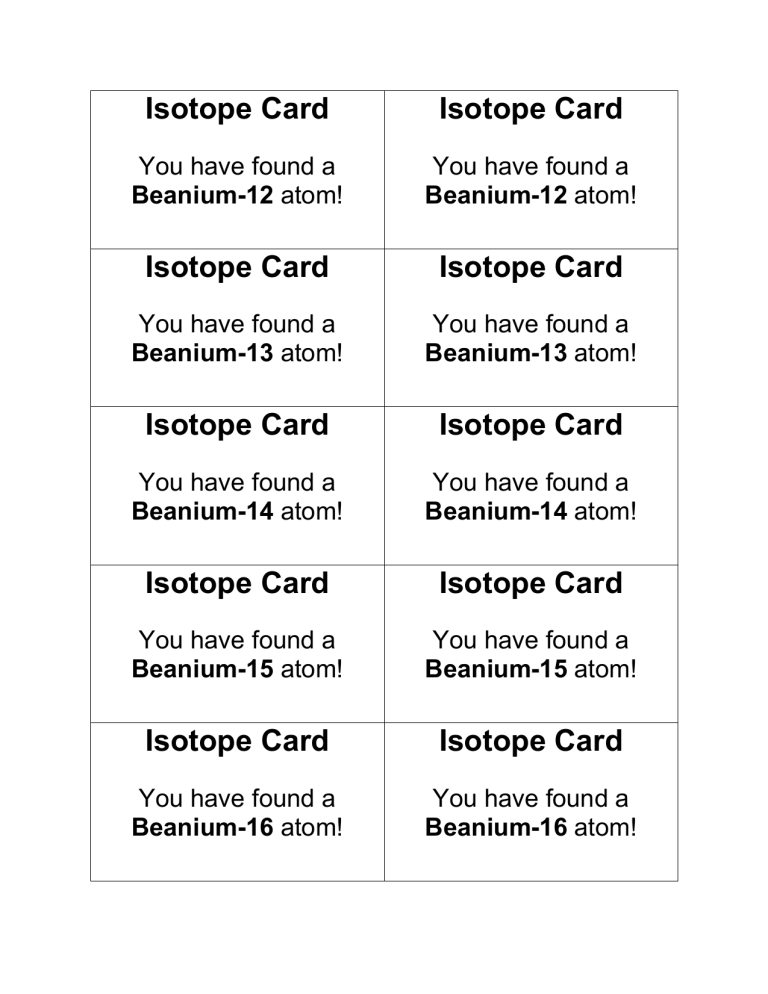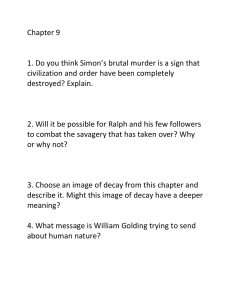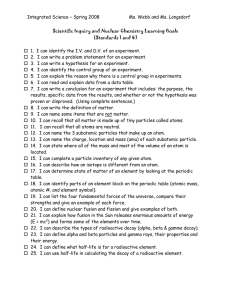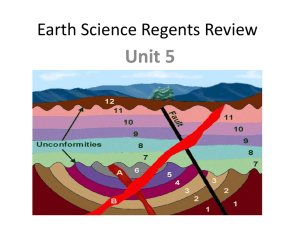
Isotope Card Isotope Card You have found a Beanium-12 atom! You have found a Beanium-12 atom! Isotope Card Isotope Card You have found a Beanium-13 atom! You have found a Beanium-13 atom! Isotope Card Isotope Card You have found a Beanium-14 atom! You have found a Beanium-14 atom! Isotope Card Isotope Card You have found a Beanium-15 atom! You have found a Beanium-15 atom! Isotope Card Isotope Card You have found a Beanium-16 atom! You have found a Beanium-16 atom! Decay Card Your atom undergoes Alpha Decay. Remove two protons and two neutrons to form an alpha particle. Decay Card Your atom undergoes Alpha Decay. Remove two protons and two neutrons to form an alpha particle. Decay Card Decay Card Your atom undergoes Beta Decay. Remove one neutron and take it to your teacher, who will give you new particles. Your atom undergoes Beta Decay. Remove one neutron and take it to your teacher, who will give you new particles. Decay Card Decay Card Your atom undergoes Gamma Decay. Only energy is released. There is no change to the nucleus. Your atom undergoes Gamma Decay. Only energy is released. There is no change to the nucleus. Decay Card Decay Card Your atom undergoes Fission to form Carbon-11 and a Hydrogen isotope. Your atom undergoes Fission to form Boron-10 and a Helium isotope. Decay Card Decay Card Your atom undergoes Fission to form Lithium-7 and a Beryllium isotope. Your atom undergoes Alpha Decay. Remove two protons and two neutrons to form an alpha particle. Set-Up & Game Instructions: Symbol for Beanium = 7Bn Students play in pairs with one set of cards. 10 blue Isotope cards & 10 green decay cards. (+ additional 4 Fusion cards & 6 more decay cards if desired). May add additional decay cards to extend each round if desired. GREEN cards should be shuffled randomly. BLUE cards should be separated into 2 sets – 1 for each player- containing randomly shuffled Beanium-12, 13, 14 ,15 16 so that each player has opportunity to build each isotope once. (Another option is to print the blue cards on 2 different shades of blue to make this easier to keep sorted). Beanium has 7 protons and 7 electrons. To determine the number of neutrons, a player will first need to draw a blue card to indicate which isotope to build. Each particle is represented by a different type “bean” (beans or other small manipulative) for example: o black beans = protons, o white beans = neutrons, o corn kernel = electrons & o tiny seed (or mini macaroni) = photon (gamma radiation). Each player has a paper plate to keep the beans, etc from scattering. The plate represents the atom. Round 1: Player A draws a BLUE card and builds the Isotope of Beanium indicated. o EXAMPLE: a Beanium-15 card is drawn. Student puts 7 black beans, 8 white beans and 7 corn kernels on the plate & shows it to partner to check if correct. o Player B records the isotope symbol on his/her data sheet for Isotope 1. Player B draws a BLUE card and builds the corresponding isotope & shows to partner, then records the appropriate symbol on data sheet for Isotope 1. Player A now draws a green Decay card and follows instructions & shows to Player B to check. Then record decay equation on data sheet. Make sure mass is conserved in the equation by showing all particles, including any energy released as a photon (Gamma). Player B draws a green decay card and follows instructions, sows to Player A and records the decay equation on data sheet for Isotope 1. This ends Round 1. Play 5 or more rounds (if no fusion cards) so each player has a chance to build each isotope and try each type of decay or other process. If there are fusion cards in the deck, play enough rounds for each player to have each isotope AND demonstrate each type of nuclear process. Shuffle cards if you run out before completing play. MODIFCATION: Add Fusion decay cards and provide extra “beans” accordingly. You may also want to include extra decay cards and have players stop when their atom decays to Beanium-12 or else to a lighter element resulting from Fission or alpha decay. Beanium Card Game Nuclear Processes Review Activity Set Up & Instructions: A new element called “Beanium, (Bn)” has been discovered. This element has 7 protons and several isotopes with various numbers of neutrons. The isotopes discovered so far are Beanium-12, Beanium13, Beanium-14, Beanium-15, and Beanium-16. All of these Beanium isotopes are radioactive. The symbol for Beanium has been written as Bn. You will use a deck of cards with a partner to practice writing equations for various nuclear processes, including Fission and Fusion. Set-Up: You and your partner should have the following cards: Blue Cards 2 Beanium-12 2 Beanium-13 2 Beanium-14 2 Beanium-15 2 Beaninum-16 (Each player should have one of each, shuffle before playing) Green Cards 6 Alpha decay 4 Beta decay 3 Gamma decay 3 Fission 4 Fusion (1 common set, shuffle before playing) Other Each player should have a paper plate. Each player should have a blank data sheet Each pair of players needs a bag of black beans, white beans, and corn kernels and a bag of either small seed or some macaroni shells Playing the Game: Round 1: Player A draws a BLUE card and builds the Isotope of Beanium indicated. o EXAMPLE: a Beanium-15 card is drawn. Student puts 7 black beans, 8 white beans and 7 corn kernels on the plate & shows it to partner to check if correct. o Player A records the isotope symbol on his/her data sheet for Isotope 1. Player B draws a BLUE card and builds the corresponding isotope & shows to partner, then records the appropriate symbol on data sheet for Isotope 1. Player A now draws a green Decay card and follows instructions & shows to Player B to check. Then record decay equation on data sheet. Make sure mass is conserved in the equation by showing all particles, including any energy released as a photon (Gamma). Player B draws a green decay card and follows instructions, shows to Player A and records the decay equation on data sheet for Isotope 1. This ends Round 1. Play 5 or more rounds (if no fusion cards) so each player has a chance to build each isotope and try each type of decay or other process. If there are fusion cards in the deck, play enough rounds for each player to have each isotope AND demonstrate each type of nuclear process. Shuffle cards if you run out before completing play. Name _____________________________________ Partner_______________ Period _____________ DATA SHEET Write an Equation for the Nuclear Process each of your isotopes undergoes: Example Trial Type of Decay: Sketch: Alpha Equation: Trial 1 Type of Decay: Sketch: Equation: Trial 2 Type of Decay: Sketch: Equation: Trial 3 Type of Decay: Sketch: Equation: Trial 4 Type of Decay: Sketch: Equation: Trial 5 Type of Decay: Sketch: Equation: Trial 6 Type of Decay: Sketch: Equation: Trial 7 Type of Decay: Sketch: Equation: Trial 8 Type of Decay: Sketch: Equation: Trial 9 Type of Decay: Sketch: Equation: Trial 10 Type of Decay: Sketch: Equation: Decay Card Your atom undergoes Alpha Decay. Remove two protons and two neutrons to form an alpha particle. Decay Card Your atom undergoes Alpha Decay. Remove two protons and two neutrons to form an alpha particle. Decay Card Decay Card Your atom undergoes Beta Decay. Remove one neutron and take it to your teacher, who will give you new particles. Your atom undergoes Beta Decay. Remove one neutron and take it to your teacher, who will give you new particles. Decay Card Decay Card Your atom undergoes Gamma Decay. Only energy is released. There is no change to the nucleus. Your atom undergoes Gamma Decay. Only energy is released. There is no change to the nucleus. Fusion Card Fusion Card Your atom undergoes Fusion with a Helium atom to form an unstable isotope. Build the correct isotope and draw another decay card. (If the Your atom undergoes Fusion with your partner’s Beanium atom to form an unstable isotope. Build the correct isotope and draw another decay card. (If the new card is Fission, new card is Fission, discard it and draw again). discard it and draw again). Fusion Card Your atom undergoes Fusion with a Helium atom to form an unstable isotope. Build the correct isotope and draw another decay card. (If the new card is Fission, discard it and draw again). Fusion Card Your atom undergoes Fusion with an identical Beanium atom to form an unstable isotope. Build the correct isotope and draw another decay card. (If the new card is Fission, discard it and draw again). Print on green construction paper







